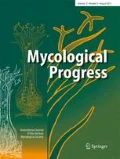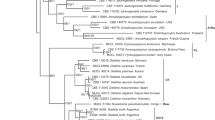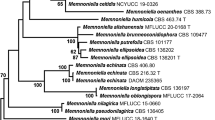Abstract
During a survey of xylarialean Sordariomycetes in North-western Argentina, several collections representing a new species morphologically resembling the pantropical Hypoxylon monticulosum was encountered. They were studied by a combination of morphological and chemotaxonomic studies along with a multi-locus phylogeny of Hypoxylon and related genera of the Hypoxylaceae based on a combined ITS, LSU, TUB2, and RBP2 dataset. The phylogenetic tree revealed that DNA sequences of the new fungus clustered together with Hypoxylon monticulosum and Hypoxylon submonticulosum in a separate clade. In addition, all representatives of this clade produced the antifungal polyketides of the sporothriolide type in standardized submerged cultures. Furthermore, a comparison of the morphology of this group of species formerly placed in Hypoxylon, including H. austrobahiense and H. rubigineoareolatum, also revealed certain morphological similarities. They are therefore accommodated in the new genus Hypomontagnella, with Hypomontagnella monticulosa as type species, and the new Argentine fungus is described as Hypomontagnella barbarensis.






Similar content being viewed by others
References
Bills GF, Gonzalez-Menendez V, Martın J, Platas G, Fournier J, Persoh D, Stadler M (2012) Hypoxylon pulicicidum sp. nov. (Ascomycota, Xylariales), a pantropical insecticide-producing endophyte. PLoS One 7:e46687
Bitzer J, Læssøe T, Fournier J, Kummer V, Decock C, Tichy HV, Piepenbring M, Persǒh D, Stadler M (2008) Affinities of Phylacia and the daldinoid Xylariaceae, inferred from chemotypes of cultures and ribosomal DNA sequences. Mycol Res 112:251–270
Cao LL, Zhang YY, Liu YJ, Yang TT, Zhang JL, Zhang ZG, Shen L, Liu JY, Ye YH (2017) Anti-phytopathogenic activity of sporothriolide, a metabolite from endophyte Nodulisporium sp. A21 in Ginkgo biloba. Pestic Biochem Physiol 129:7–13
Daranagama DA, Camporesi E, Tian Q, Liu X, Chamyuang S, Stadler M, Hyde KD (2015) Anthostomella is polyphyletic comprising several genera in Xylariaceae. Fungal Divers 73:203–238
Daranagama DA, Hyde KD, Sir EB, Thambugala KM, Tian Q, Samarakoon MC, McKenzie EHC, Jayasiri SC, Tibpromma S, Bhat JD, Liu X, Stadler M (2018) Towards a natural classification and backbone tree for Graphostromataceae, Hypoxylaceae, Lopadostomataceae and Xylariaceae. Fungal Divers 88:1–165
Fournier J, Stadler M, Hyde KD, Duong LM (2010) The new genus Rostrohypoxylon and two new Annulohypoxylon species from northern Thailand. Fungal Divers 40:23–36
Guindon S, Dufayard JF, Lefort V, Anisimova M, Hordijk W, Gascuel O (2010) New algorithms and methods to estimate maximum-likelihood phylogenies: assessing the performance of PhyML 3.0. Syst Biol 59:307–321
Helaly SE, Thongbai B, Stadler M (2018) Diversity of biologically active secondary metabolites from endophytic and saprotrophic fungi of the ascomycete order Xylariales. Nat Prod Rep 35:992–1014
Hsieh HM, Ju YM, Rogers JD (2005) Molecular phylogeny of Hypoxylon and closely related genera. Mycologia 97:844–865
Johannesson H (2000) Ecology of Daldinia spp. with special emphasis on Daldinia loculata. Doctoral thesis, Swedish University of Agricultural Sciences, Uppsala, Sweden. 43pp
Ju YM, Rogers JD (1996) A revision of the genus Hypoxylon. Mycologia Memoir n° 20. APS Press, St. Paul 365 pp
Kearse M, Moir R, Wilson A, Stones-Havas S, Cheung M, Sturrock S, Buxton S, Cooper A, Markowitz S, Duran C, Thierer T, Ashton B, Mentjies P, Drummond A (2012) Geneious basic: an integrated and extendable desktop software platform for the organization and analysis of sequence data. Bioinformatics 28:1647–1649
Kuhnert E, Fournier J, Peršoh D, Luangsa-ard JJD, Stadler M (2014) New Hypoxylon species from Martinique and new evidence on the molecular phylogeny of Hypoxylon based on ITS rDNA and β-tubulin data. Fungal Divers 64:181–203
Kuhnert E, Sir EB, Lambert C, Hyde KD, Hladki AI, Romero AI, Rohde M, Stadler M (2017) Phylogenetic and chemotaxonomic resolution of the genus Annulohypoxylon (Xylariaceae) including four new species. Fungal Divers 85:1–43
Lefort V, Longueville JE, Gascuel O (2017) SMS: smart model selection in PhyML. Mol Biol Evol 34:2422–2224
Leman-Loubière C, Le Goff G, Retailleau P, Debitus C, Ouazzani J (2017a) Sporothriolide-related compounds from the fungus Hypoxylon monticulosum CLL-205 isolated from a Sphaerocladina sponge from the Tahiti coast. J Nat Prod 80:2850–28544
Leman-Loubière C, Le Goff G, Debitus C, Ouazzani J (2017b) Sporochartines A–E, a new family of natural products from the marine fungus Hypoxylon monticulosum isolated from a Sphaerocladina sponge. Front Mar Sci 4:399
Liu YL, Whelen S, Hall BD (1999) Phylogenetic relationships among ascomycetes: evidence from a RNA polymerase II subunit. Mol Biol Evol 16:1799–1808
Miller JH (1961) A monograph of the world species of Hypoxylon. University of Georgia Press, Athens 158 p
Rayner RW (1970) A mycological colour chart. Commonwealth Mycological Institute, Kew and British Mycological Society
Sir EB, Kuhnert E, Lambert C, Hladki AI, Romero AI, Stadler M (2016) New species and reports of Hypoxylon from Argentina recognized by a polyphasic approach. Mycol Prog 15:42
Stadler M, Fournier J, Læssøe T, Decock C, Peršoh D, Rambold G (2010) Ruwenzoria, a new genus of the Xylariaceae from Central Africa. Mycol Prog 9:169–179
Stadler M, Kuhnert E, Peršoh D, Fournier J (2013) The Xylariaceae as model example for a unified nomenclature following the “one fungus-one name” (1F1N) concept. Mycology 4(1):5–21
Stadler M, Læssøe T, Fournier J, Decock C, Schmieschek B, Tichy HV, Peršoh D (2014) A polyphasic taxonomy of Daldinia (Xylariaceae). Stud Mycol 77:1–143
Surup F, Kuhnert E, Lehmann E, Heitkämper S, Hyde KD, Fournier J, Stadler M (2014) Sporothriolide derivatives as chemotaxonomic markers for Hypoxylon monticulosum. Mycol Int J Fungal Biol 5:110–119
Talavera G, Castresana J (2007) Improvement of phylogenies after removing divergent and ambiguously aligned blocks from protein sequence alignments. Syst Biol 56:564–577
Tang AM, Jeewon R, Hyde KD (2007) Phylogenetic relationships of Nemania plumbea sp. nov. and related taxa based on ribosomal ITS and RPB2 sequences. Mycol Res 111:392–402
Triebel D, Peršoh D, Wollweber H, Stadler M (2005) Phylogenetic relationships among Daldinia, Entonaema, and Hypoxylon as inferred from ITS nrDNA analyses of Xylariales. Nova Hedwigia 80(1–2):25–43
Wendt L, Sir EB, Kuhnert E, Heitkämper S, Lambert C, Hladki AI, Romero AI, Luangsa-ard JJ, Srikitikulchai P, Peršoh D, Stadler M (2018) Resurrection and emendation of the Hypoxylaceae, recognised from a multi-gene genealogy of the Xylariales. Mycol Prog 17:115–154
Acknowledgements
The authors express their appreciation to the Administración de Parques Nacionales of Argentina, Ministerio de Medio Ambiente of Salta Province and Dirección Provincial de Biodiversidad of Jujuy Province for authorization of collection.
LW gratefully acknowledges a PhD stipend from the Hannover School for Biomolecular Drug Research (HSBDR). The German Academic Exchange Service (DAAD) and the Argentina Ministerio de Ciencia, Tecnología e Innovación Productiva are gratefully acknowledged for an academic exchange grant to AIH and EBS. We gratefully acknowledge support from the curators of various international herbaria, and to all our co-authors of previous papers on the Xylariales. In particular, we thank Andrea I. Romero (UBA-CONICET) for her invaluable work on the taxonomy of xylarialean fungi from Northwestern Argentina. Manfred Rohde is thanked for SEM recordings. Vanessa Stiller and Anke Skiba are thanked for expert technical assistance and Nadine Wurzler is thanked for sequencing work.
Author information
Authors and Affiliations
Corresponding author
Additional information
Section Editor: Roland Kirschner
This article is part of the “Special Issue on hyphomycete taxonomy and diversity in honour of Walter Gams who passed away in April 2017.”
Rights and permissions
About this article
Cite this article
Lambert, C., Wendt, L., Hladki, A.I. et al. Hypomontagnella (Hypoxylaceae): a new genus segregated from Hypoxylon by a polyphasic taxonomic approach. Mycol Progress 18, 187–201 (2019). https://doi.org/10.1007/s11557-018-1452-z
Received:
Revised:
Accepted:
Published:
Issue Date:
DOI: https://doi.org/10.1007/s11557-018-1452-z




